Saturation Function Description (EOR-BO)
Mixed-Wet sP Function
The mixed-wet sP functions in STOMP-EOR use a base function, such as the van Genuchten function[2] or the Brooks and Corey function[1]. For a contact angle of 0˚ the base function is used in its original form, yielding a relationship between aqueous saturation and the nonaqueous-liquid to aqueous capillary head. This function is shown as the black line in Figure 1, for an example van Genuchten base function[2], and in Figure 2 for a similar Brooks and Corey base function[2]. In both of these plots the gas saturation is set to 0.0, yield a total liquid saturation of 1.0. For a contact angle of 180˚ the base function is used in its original form, but with the negative of the nonaqueous-liquid to aqueous capillary head, yielding the nonaqueous-liquid saturation. The aqueous saturation is then computed from the difference in gas saturation and nonaqueous-liquid saturation. This function is shown as the purple line in Figures 1 and 2, respectively for the example van Genuchten[2] and Brooks and Corey base functions[1].

Figure 1. Aqueous Saturation versus Capillary Head using the van Genuchten Function[2] with Total-Liquid Saturation = 1.0

Figure 2. Aqueous Saturation versus Capillary Head using the Brooks and Corey Function[1] with Total-Liquid Saturation = 1.0
Phase Capillary Pressures from Phase Saturations
The STOMP-EOR simulator considers three immiscible phases: 1) aqueous, 2) nonaqueous-liquid, and 3) gas. The total-liquid saturation is the sum of the aqueous and nonaqueous-liquid saturations and is a function of the capillary pressure between the gas and greater of the aqueous and nonaqueous-liquid pressure. The aqueous and nonaqueous saturations are functions of the total-liquid saturation and the nonaqueous-liquid to aqueous capillary pressure, which for mixed-wet systems can be positive or negative. Given the three phase saturations, thenonaqueous-liquid to aqueous capillary pressure is determined from contact-angle-scaled nonaqueous-liquid to aqueous and aqueous to nonaqueous-liquid indicial capillary heads:
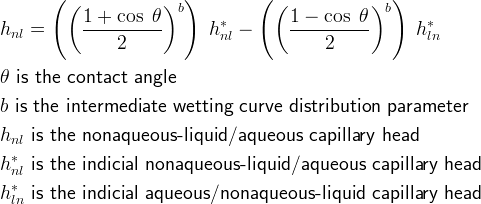
The "b" parameter is used to adjust the distribution of intermediate wetting curves between the aqueous-wet and nonaqueous-liquid wet limits. The indicial nonaqueous-liquid to aqueous capillary pressure is determined from the base sP function, from the effective indicial aqueous saturation:
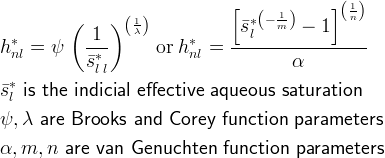
and the indicial aqueous to nonaqueous-liquid capillary pressure is determined from the base sP function, from the effective indicial nonaqueous-liquid saturation:
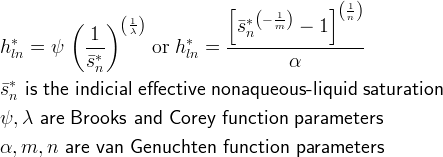
The effective indicial aqueous and nonaqueous-liquid saturations are determined from the indicial actual saturations and the indicial residual saturations:

The indicial actual aqueous and nonaqueous saturations are independent of the gas saturation:

The indicial residual aqueous and nonaqueous saturations are determined from contact-angle-scaled actual residual saturations:

Phase Saturations from Phase Capillary Pressures
The mixed-wet sP function described in the Phase Capillary Pressures from Phase Saturations section above can not be inverted analytically, yielding a function for phase saturation from phase capillary pressures. As the normal calculation path in STOMP-EOR will be from phase saturations to phase capillary pressures, this limitation will not hinder the numerical efficiency of the simulator. For situations where the phase saturation is required from the phase capillary pressures, an iterative numerical solution is used. A bounded Newton-Raphson scheme yields phase saturations to an accuracy of 10-9 within several iterations near the middle of the curves, and generally within eight iterations near the saturation extremes. The Newton-Raphson scheme requires an initial guess of the principal unknown, which has been chosen as the aqueous saturation. An initial guess of the aqueous saturation is found by evaluating an indicial aqueous saturation from the pure aqueous-wet curve, using the nonaqeuous-liquid to aqueous capillary head:
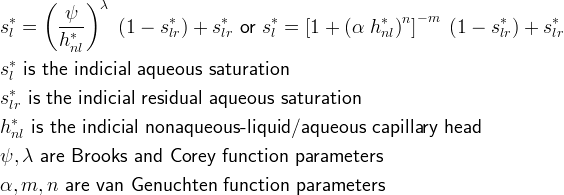
and an indicial nonaqueous-liquid saturation form the pure nonaqueous-liquid-wet curve, using the aqueous to nonaqueous-liquid capillary head (i.e., the negative of the nonaqueous-liquid to aqueous capillary head:

These two indicial saturations are then combined, using contact angle scaling, to estimate the aqueous saturation:

This estimate is then used as the starting point for the Newton-Raphson scheme, applied to the functions describing the calculation of phase capillary pressure from phase saturation.
Extension Below Residual Saturation
sP Functions describe the relationship between interphase capillary pressure and phase saturation. STOMP-EOR is currently being developed as a three phase simulator: 1) gas, 2) aqueous, and 3) nonaqueous liquid. The liquid phases (i.e., aqueous and nonaqueous liquid) are assumed wet the solid surfaces of the geologic media. The gas phase is assumed to be the nonwetting phase. The
The injection of CO2 into a reservoir has the potential of forcing the total-liquid saturation below the residual saturation. Conventional capillary pressure and saturation functions are limited to saturations above the residual saturation. For these functions, the capillary pressure tends toward infinity as the aqueous saturation approaches the residual saturation. This limitation can be overcome by specifying an extension option for the either the van Genuchten[2] or Brooks and Corey[1] characteristic functions. The Webb[3] extension divides the capillary pressure-saturation function into two regimes. For low aqueous saturation the function follows a logarithmic form, and for moderate to high saturations the function follows the specified form (e.g., van Genuchten[2], Brooks and Corey[1]). Transition between the two forms occurs at the matching point, which occurs at the point where the two functions have matching slopes. The low-saturation function is a linear function on a semilog plot:

The matching point saturation and capillary pressure head is determined by setting the partial derivative of the aqueous saturation with respect to the capillary pressure head in Webb equation equal to the partial derivative of the aqueous saturation with respect to the capillary pressure head in the specified function form (e.g., van Genuchten[2] or Brooks and Corey[1]), setting the capillary pressure head to the matching point capillary pressure head, setting the aqueous saturation to the matching point aqueous saturation and solving for the matching point aqueous saturation. A nonlinear solve is required to determine the matching point saturation and capillary pressure head for the van Genuchten[2] or Brooks and Corey[1] functions, but this solution is only required once, during simulation initialization. An oven-dried head of 109Pa (~105 m) is used for the Webb[3] extension model.
For a gas-nonaqueous liquid-aqueous mixed-wet system three matching point saturations and heads are required: 1) gas-total liquid, 2) nonaqueous liquid-aqueous, and 3) aqueous-nonaqueous liquid. The sP curves are divided into two components. Below the matching-point saturation or above the matching-point head the Webb[3] extension is used. Conversely above the matching-point saturation or below the matching-point head the conventional base function is used. The form of the Webb[3] extension provides for a smooth transition across the matching-point. For the mixed-wet system thehead-shifted actual aqueous saturation is computed from either the base sP function or Webb[3] extension, using a contact-angle shifted nonaqueous-liquid to aqueous capillary head.

The head-shifted actual nonaqueous-liquid saturation is computed from either the base sP function or Webb[3] extension, using a contact-angle shifted aqueous to nonaqueous-liquid capillary head.
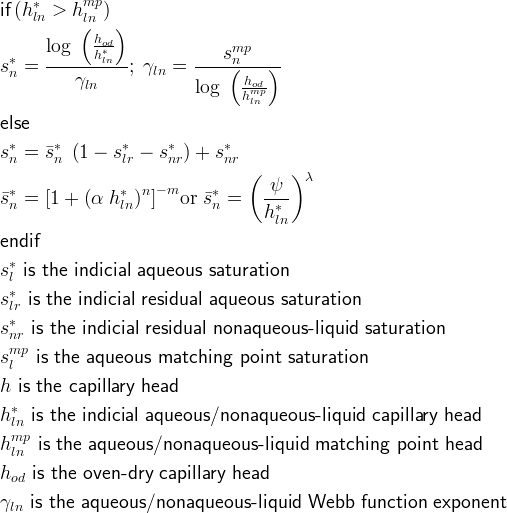
The actual total-liquid saturation is computed from the base sP function or Webb[3] extension, using the gas to total-liquid capillary head; where, the total-liquid pressure is the maximum of the aqueous and nonaqueous-liquid pressure.

An example of the Webb[3] extension applied in conjunction with the van Genuchten[2] and Brooks and Corey[1] base functions for a mixed-wet system are shown in Figures 3 and 4, respectively.

Figure 3. Aqueous Saturation versus Capillary Head using the van Genuchten[2] Function with Total-Liquid Saturation = 1.0

Figure 4. Aqueous Saturation versus Capillary Head using the Brooks and Corey[1] Function with Total-Liquid Saturation = 1.0
References
1. Brooks, R.H. and Corey, A.T.: “Hydraulic properties of porous media,” Hydraulic paper no. 3, Colorado State University, 1964.
2. van Genuchten, M. Th. 1980. “A closed-form equation for predicting the hydraulic conductivity of unsaturated soils.” Soil Sci. Soc. Am. J., 44:892-898.
3. Webb, S. W., 2000. “A simple extension of two-phase characteristic curves to include the dry region.” Water Resources Research, 36(6):1425-1430.
STOMP User Guide Home
- Simulation Title Card
- Solution Control Card
- Grid Card
- Inactive Nodes Card
- Rock/Soil Zonation Card
- Mechanical Properties Card
- Hydraulic Properties Card
- Saturation Function Card
- 3 Phase Relative Permeability Card
- Salt Transport Card
- Black Oil Properties Card
- Solute/Fluid Interaction Card
- Solute/Porous Media Interaction Card
- Initial Conditions Card
- Boundary ConditionsCard
- SourceCard
- Coupled Well Card
- Output Control Card
- Surface Flux Card
